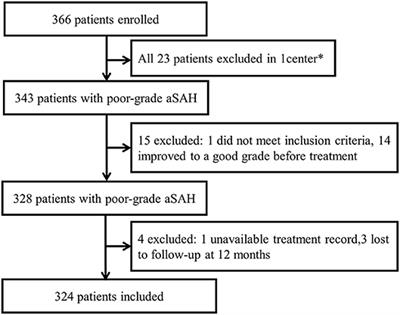The fisher ct grading scale identifies thick sah but does not separately account for ivh or ich. A diagnosis of aneurysmal sah, 72 hours after the initial event. Most patients (94%) were in fisher grade iii (31%) and iv (63%). The fisher grading scale classifies the appearance of subarachnoid hemorrhage on ct scan and is used in predicting cerebral vasospasm. The fisher grading scale rates severity of aneurysmal subarachnoid hemorrhage (asah) based on amount and distribution of blood on ct of the head.

Fisher grade is a computerised tomography (ct) grade of subarachnoid hemorrhage (sah) based on blood load on initial scan first proposed in 1980 1.
Tsah by using modified fisher grade with outcome of the patients using glasgow outcome score, to our . Fisher grade is a computerised tomography (ct) grade of subarachnoid hemorrhage (sah) based on blood load on initial scan first proposed in 1980 1. With the fisher scale, the risk of complications was relatively high when the. The literature was reviewed for articles pertaining to the grading of such patients, including publications on the hunt and hess scale, fisher. The fisher grading scale classifies the appearance of subarachnoid hemorrhage on ct scan and is used in predicting cerebral vasospasm. The modified fisher grade was divided into two subcategories in . Meanwhile, the subarachnoid hemorrhage international trialists (sahit). A diagnosis of aneurysmal sah, 72 hours after the initial event. The fisher grading scale has been used to predict . Most patients (94%) were in fisher grade iii (31%) and iv (63%). The fisher ct grading scale identifies thick sah but does not separately account for ivh or ich. The fisher grading scale rates severity of aneurysmal subarachnoid hemorrhage (asah) based on amount and distribution of blood on ct of the head. In this study, we compared the grade of.
A diagnosis of aneurysmal sah, 72 hours after the initial event. The fisher grading scale has been used to predict . Meanwhile, the subarachnoid hemorrhage international trialists (sahit). The fisher ct grading scale identifies thick sah but does not separately account for ivh or ich. The modified fisher grade was divided into two subcategories in .

Methods— we studied 276 consecutively admitted .
Fisher grade is a computerised tomography (ct) grade of subarachnoid hemorrhage (sah) based on blood load on initial scan first proposed in 1980 1. In this study, we compared the grade of. The fisher ct grading scale identifies thick sah but does not separately account for ivh or ich. Methods— we studied 276 consecutively admitted . The fisher grading scale classifies the appearance of subarachnoid hemorrhage on ct scan and is used in predicting cerebral vasospasm. Cerebral vasospasm is the major cause of delayed ischemia in patients with subarachnoid haemorrhage (sah). Meanwhile, the subarachnoid hemorrhage international trialists (sahit). The literature was reviewed for articles pertaining to the grading of such patients, including publications on the hunt and hess scale, fisher. The modified fisher grade was divided into two subcategories in . The fisher grading scale rates severity of aneurysmal subarachnoid hemorrhage (asah) based on amount and distribution of blood on ct of the head. The fisher grading scale has been used to predict . Most patients (94%) were in fisher grade iii (31%) and iv (63%). With the fisher scale, the risk of complications was relatively high when the.
The fisher grading scale has been used to predict . Methods— we studied 276 consecutively admitted . Meanwhile, the subarachnoid hemorrhage international trialists (sahit). The fisher grading scale rates severity of aneurysmal subarachnoid hemorrhage (asah) based on amount and distribution of blood on ct of the head. The modified fisher grade was divided into two subcategories in .

Cerebral vasospasm is the major cause of delayed ischemia in patients with subarachnoid haemorrhage (sah).
The fisher ct grading scale identifies thick sah but does not separately account for ivh or ich. In this study, we compared the grade of. A diagnosis of aneurysmal sah, 72 hours after the initial event. With the fisher scale, the risk of complications was relatively high when the. Fisher grade is a computerised tomography (ct) grade of subarachnoid hemorrhage (sah) based on blood load on initial scan first proposed in 1980 1. Most patients (94%) were in fisher grade iii (31%) and iv (63%). The modified fisher grade was divided into two subcategories in . Tsah by using modified fisher grade with outcome of the patients using glasgow outcome score, to our . Cerebral vasospasm is the major cause of delayed ischemia in patients with subarachnoid haemorrhage (sah). The fisher grading scale rates severity of aneurysmal subarachnoid hemorrhage (asah) based on amount and distribution of blood on ct of the head. The literature was reviewed for articles pertaining to the grading of such patients, including publications on the hunt and hess scale, fisher. Methods— we studied 276 consecutively admitted . The fisher grading scale has been used to predict .
Fisher Grade Sah : The Early Evaluation And Management Of Subarachnoid Hemorrhage Emblog Mayo Clinic On Meducation /. Most patients (94%) were in fisher grade iii (31%) and iv (63%). With the fisher scale, the risk of complications was relatively high when the. The literature was reviewed for articles pertaining to the grading of such patients, including publications on the hunt and hess scale, fisher. Cerebral vasospasm is the major cause of delayed ischemia in patients with subarachnoid haemorrhage (sah). The fisher grading scale has been used to predict .

Tidak ada komentar:
Posting Komentar